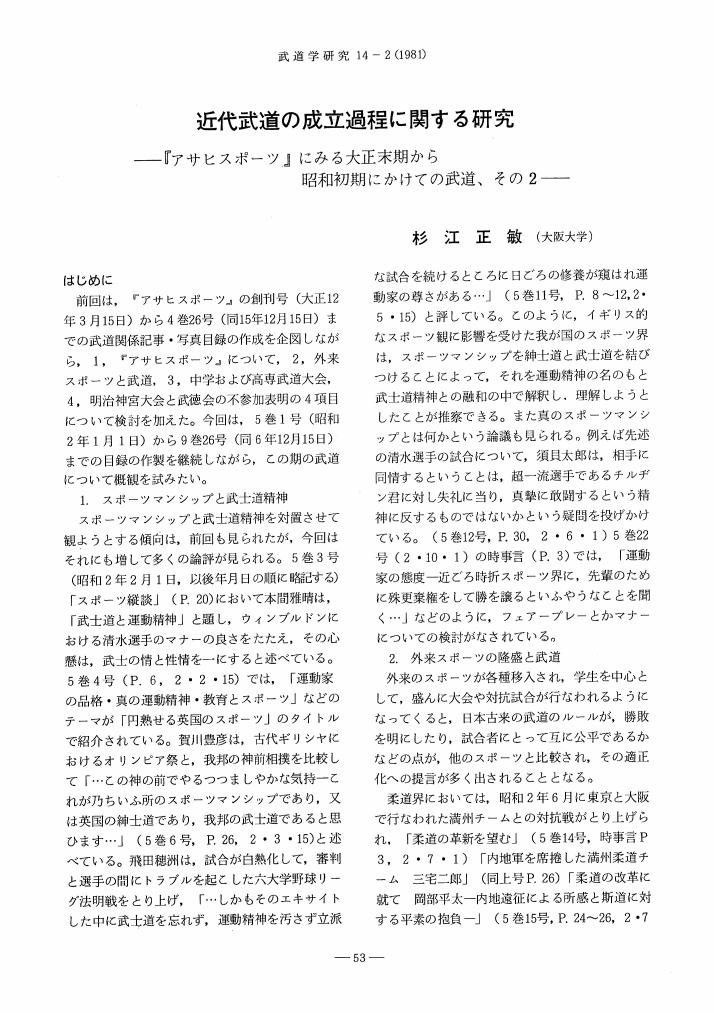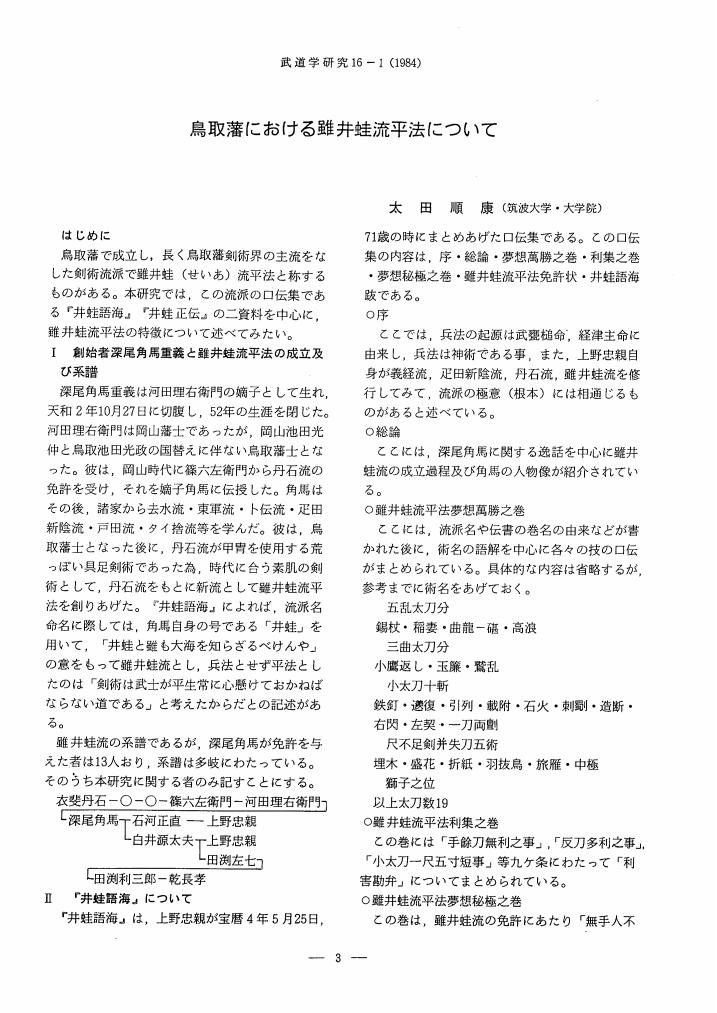2 0 0 0 OA 剣道の素振りにおける古流経験者と古流未経験者の比較
- 著者
- 小林 義雄 百鬼 史訓
- 出版者
- 日本武道学会
- 雑誌
- 武道学研究 (ISSN:02879700)
- 巻号頁・発行日
- vol.23, no.2, pp.57-58, 1990-11-30 (Released:2012-11-27)
2 0 0 0 OA 剣道における打突が人体の頭部に及ぼす影響について―ダミーを用いたシミュレーション実験―
- 著者
- 百鬼 史訓 横山 直也 有田 祐二 久保 哲也 山神 眞一
- 出版者
- 日本武道学会
- 雑誌
- 武道学研究 (ISSN:02879700)
- 巻号頁・発行日
- vol.37, no.3, pp.1-11, 2005-03-31 (Released:2012-11-27)
- 参考文献数
- 16
本研究は,剣道において面や突きなどを打突された際に,剣道具(面)をとおして人体の頭部に伝達される衝撃力について,バイオメカニクス的観点から明らかにするために,打撃用ダミー人形や被験者への実戦的な打突が頭部へ及ぼす力学量(加速度)を計測し,頭部の安全性についてJARIの人体頭部耐性曲線を元に検討することを目的とした。得られた結果をまとめると以下の通りである。1.一足一刀の間合からの面打撃は,加速度レベルが低いため,加速度による傷害発生の可能性が3種類(MA:その場から,MB:送り足で,MC:一足一刀の間合から)の打ち込み条件の中では最も低かった。2.頭部への一回の打撃により頭蓋骨々折・脳震盪といった傷害が生じるレベルには達していない。しかし,慢性硬膜下血腫の発症との関連も心配されることから,連続的な衝撃や長年にわたる衝撃の影響について,今後検討する必要があると考える。3.突き動作では加速度レベルが低いため,加速度による頭部の傷害発生の可能性は低いと考えられる。
2 0 0 0 OA 弓道の「手の内の働き」に関する生体工学的研究
- 著者
- 細谷 聡 加賀 勝
- 出版者
- 日本武道学会
- 雑誌
- 武道学研究 (ISSN:02879700)
- 巻号頁・発行日
- vol.35, no.2, pp.11-18, 2002-11-30 (Released:2012-11-27)
- 参考文献数
- 12
Since a Japanese-style bow is very complicated in both shape and structure, torques in horizontal and sagittal planes regarding grip must be applied to hit the target. This study biomechanically investigated the relationship between left forearm muscular activities and torques in horizontal (called the “NEJIRI” technique) and sagittal planes (called the “UWAOSHI” technique)regarding grip.Surface EMGs of four muscles (extensor carpi radialis longus, extensor digitorum, extensor carpi ulnaris, flexor carpi ulnaris) were collected from ten male subjects shooting arrows. The habit of the motion of drawing the bows that is called “BIKU” was measured incidentally from the experiment. As a result of statistics analysis, extensor digitorum and extensor carpi ulnaris muscles had positive relationships to the torque in the horizontal plane (“NEJIRI” technique). On the other hand, extensor carpi ulnaris and flexor carpi ulnaris muscles had positive relationships to the torque in the sagittal plane (“UWAOSHI” technique). It is suggested that extensor carpi ulnaris is complicatedly controlled to accomplish the operation of “TENOUCHI”, the shooting technique, in KYUDO.
2 0 0 0 OA 筋電図からみた弓道の「手の内の働き」
- 著者
- 加賀 勝
- 出版者
- 日本武道学会
- 雑誌
- 武道学研究 (ISSN:02879700)
- 巻号頁・発行日
- vol.19, no.2, pp.45-46, 1986 (Released:2012-11-27)
- 参考文献数
- 6
2 0 0 0 OA 弓道における矢の貫徹力に関する力学的考察
- 著者
- 杉江 正敏
- 出版者
- 日本武道学会
- 雑誌
- 武道学研究 (ISSN:02879700)
- 巻号頁・発行日
- vol.14, no.2, pp.53-54, 1982-01-31 (Released:2012-11-27)
2 0 0 0 OA 弓道選手用心理的スキル尺度の開発
- 著者
- 煙山 千尋
- 出版者
- 日本武道学会
- 雑誌
- 武道学研究 (ISSN:02879700)
- 巻号頁・発行日
- vol.46, no.1, pp.41-51, 2013-09-30 (Released:2014-09-30)
- 参考文献数
- 24
- 被引用文献数
- 2
The purpose of this study was to develop a psychological skills inventory for kyudo (Japanese archery) athletes. The subjects were 253 kyudo athletes in university athletic clubs (174 men and 79 women, mean age=19.98 years, SD=1.29). They were asked to answer a questionnaire that consisted of a face sheet, the psychological skills inventory for kyudo athletes (PSIKA) that was developed in this study, and their hit ratio in competitive performances of kyudo. Two weeks later, a questionnaire survey was carried out on 18 kyudo athletes (9 men and 9 women, mean age=19.83 years, SD=1.54). The result of an exploratory factor analysis revealed a seven-factor solution with 28 items of PSIKA (Image skills, Relaxation skills, Patience, Presence of mind, Confidence in shooting performance, Courteous and norm, Breath control). Each of the factors demonstrated an acceptable internal consistency with Cronbach’s alpha reliability values from 0.704 to 0.882, and test-retest reliability measured Pearson’s correlation coefficient from 0.417 to 0.657. A confirmatory factor analysis indicated that the structural validity of the PSIKA showed acceptable fit indices (GFI=0.921, AGIF=0.888, CFI=0.992, RMSEA=0.018). In terms of criterion-related validity, PSIKA except “Presence of mind” related to hit ratio (r=0.154-0.343), and “Presence of mind” related to “State anxiety” negatively (r=-0.433). These results indicated that the reliability and validity of the PSIKA as a scale for assessing psychological skills of kyudo athletes were statistically satisfied. In addition, these psychological skills had a relation to competitive performance, and improved competitive performance for kyudo athletes can be obtained by acquiring these psychological skills. In future research, in order to formulate a psychological guidance method to assist physical and technical training, PSIKA as an evaluative measure in assessing the psychological skills of kyudo athletes should be used.
2 0 0 0 IJF競技ルールの改定による柔道の組み手戦術の変化
- 著者
- 田村 昌大 廣瀬 伸良 中村 充 齊藤 仁 山内 直人 田中 力 鈴木 桂治 菅波 盛雄
- 出版者
- 日本武道学会
- 雑誌
- 武道学研究
- 巻号頁・発行日
- vol.45, no.2, pp.143-149, 2012
本研究では、2009年1月に改正されたIJF試合審判規定が柔道競技に及ぼした影響を分析・検証を行なった。その上で、試合審判規定改正の世界柔道の戦術内容に関する最新の動向を探ることを目的とした。<BR>研究方法は、収録された映像を基に2008年フランス国際柔道大会及び2009年グランドスラム・パリ国際柔道大会の競技内容を比較した。試合数は両年合わせて476試合であった。競技分析を行う上で、項目を作成した。作成した項目については、「競技分析シート2009」に競技内容を入力するものとした。<BR>組み手については、釣り手・引き手ともに持った状態で施技を行う「充分」が0.1%水準で有意な増加が認められた。また、「ズボンを直接握る」ことへの反則適用から、施技者及び相手も施技時に「脚」を持つという戦術は有意な減少が認められた。さらに、施技する際の姿勢も前傾姿勢状態からの施技は5%水準で有意な減少が認められた。<BR>ポイント取得の技術内容や組み手戦術において改正前と比較した結果では、「脚」を持つ戦術に依存しないことで「襟」「袖」を持った状態で施技可能な技術に移行するという望ましい傾向となった。<BR>今回の改正によって懸案事項となっていた点が改善される傾向にあり、IJF試合審判規定改正が影響のあるものであったと考えられたが、「肩車」にみられるような「脚」を持つ技に対する依存は未だ存在している。そのため、2010年にさらなる試合審判規定の改正につながったものと推察する。
2 0 0 0 柔道の投技における並進および回転頭部加速度の測定
2 0 0 0 OA 大日本武徳会の史的研究(2)
- 著者
- 中村 民雄
- 出版者
- 日本武道学会
- 雑誌
- 武道学研究 (ISSN:02879700)
- 巻号頁・発行日
- vol.17, no.1, pp.76-77, 1985-01-30 (Released:2012-11-27)
2 0 0 0 OA 宝蔵院流に関する研究(その6) ―筑前福岡藩の記録を中心にした高田派の伝承について―
- 著者
- 石川 哲也
- 出版者
- 日本武道学会
- 雑誌
- 武道学研究 (ISSN:02879700)
- 巻号頁・発行日
- vol.43, no.Supplement, pp.59-59, 2010 (Released:2014-04-04)
2 0 0 0 OA 弓道と肩関節可動域の関係
- 著者
- 竹澤 鮎美
- 出版者
- 日本武道学会
- 雑誌
- 武道学研究 (ISSN:02879700)
- 巻号頁・発行日
- vol.47, no.Supplement, pp.91-91, 2014 (Released:2015-09-30)
2 0 0 0 OA 鳥取藩における雖井蛙流平法について
- 著者
- 太田 順康
- 出版者
- 日本武道学会
- 雑誌
- 武道学研究 (ISSN:02879700)
- 巻号頁・発行日
- vol.16, no.1, pp.3-4, 1984-01-31 (Released:2012-11-27)
- 参考文献数
- 4
2 0 0 0 OA 徳川吉宗治世下に於ける江戸幕府武芸奨励策について
- 著者
- 横山 輝樹
- 出版者
- 日本武道学会
- 雑誌
- 武道学研究 (ISSN:02879700)
- 巻号頁・発行日
- vol.40, no.Supplement, pp.2-2, 2007 (Released:2012-11-27)
2 0 0 0 OA 和弓における催眠暗示の応用
2 0 0 0 柔道に対する意識調査(第1報):―高校生の退部動機から―
2 0 0 0 一刀流兵法と法華経―小野次郎右衛門の信仰と常楽院日経―
- 著者
- 大森 宣昌
- 出版者
- 日本武道学会
- 雑誌
- 武道学研究 (ISSN:02879700)
- 巻号頁・発行日
- vol.17, no.1, pp.108-109, 1985
2 0 0 0 OA 高齢弓道家における左室形態と機能及び行射中の循環系応答
- 著者
- 森 俊男 芳賀 脩光 松田 光生
- 出版者
- 日本武道学会
- 雑誌
- 武道学研究 (ISSN:02879700)
- 巻号頁・発行日
- vol.22, no.3, pp.46-56, 1990-03-31 (Released:2012-11-27)
- 参考文献数
- 27
The purpose of this study was to investigate the cardiac dimensions and the influences of Kyudo practice in the function of the left ventricle and responses of cardiac function during shooting. The subjects were 14 shooters whose ages were 63-85 years (the average 68.8 years old) and even now they take part in formal Kyudo matches. Total body fat was assessed by the skinfold caliper method. The left venticular structure and function were measured using M-mode echocardiography and ECG during shooting were measured by the telemeter method. Results obtained were as follows.Subjects averaged 161.9 cm in height,59.7 kg in weight and 123.4 mmHg in systolic blood pressure. Time for shooting was about 30 seconds on the average, but the shortest time was 15 seconds, and the longest was 50 seconds. There were arrhythmia in 3 subjects at rest ECG. However, there were no differences in the ecocardiographic data between shooters and normal subjects. Arrhythmia disappeared in two subjects during shooting. The heart rate during shooting averaged 110 b/min, but one shooter recorded 180 b/min at maximal level.In summary, Kyudo practice is not so hard for old age shooters, but there is possibility that it builds up blood pressure, because it needs strong muscle activity during shooting. Therefore, old shooters must always take care of their medical condition.









